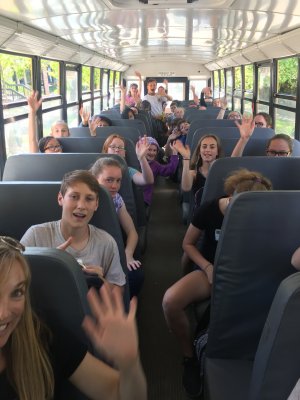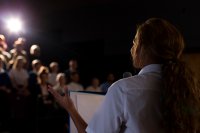Student Presenters at Education Conferences
Bringing students to professional learning conferences has benefits for both the students and educators.
Your content has been saved!
Go to My Saved Content.The audience settled in for a highly anticipated session at the Middle Grades Collaborative conference, a statewide education conference in Vermont. Jen Hill, a superstar librarian and change agent, started by noting that the session would focus on the ways in which student voice had shaped key school policies related to personalized learning.
And then she turned the presentation over to students.
The students offered their perspective on what was going well with personalized learning and what needed to change in the future. They described their leadership activities in great detail by referencing the continuum of student voice as a framework for the evolution of their work. During the Q&A, they gave candid advice that was immediately applicable for audience members.
The session was heartfelt, persuasive, insightful, and practical. What more could an educator ask for?
Student presenters are becoming increasingly common at education conferences in Vermont. At the Dynamic Landscapes conference in May, for example, there were over 100 students presenting or participating to enhance the professional learning of educators. This is a substantial student presence for a two-day conference averaging 350 attendees per day.
While it’s especially important to put students front and center at events that are meant to promote and support student-centered learning, I would argue that the student perspective will enhance almost any type of professional learning by educators.

5 Reasons to Bring Students to Conferences
1. Your audience will appreciate it: Shifts in practice are heard in a different way when they’re described by students. Especially when your audience includes educators, the practices you’re promoting and risks you’re taking will sound much more authentic and convincing coming from students. After a student-led session, one teacher turned to me and said, “I need to create a classroom where students are leading, like these kids.”
2. Your students will present to an authentic audience: Students get to provide their perspective—and potentially share their work, depending on your topic—to interested educators, underscoring the purpose of school in general and the practices that you are presenting in particular. Whether students present projects they’ve created or share ideas as student leaders, conferences are a great venue for a culminating event.
3. Your students will be engaged and empowered: Young people are motivated and inspired when their ideas about schooling and learning take center stage. They realize that they bring valuable expertise as students that enriches the professional learning of educators. As one student put it after facilitating an anti-bias workshop for educators, “I was really being listened to.”
4. Your students will learn: Students will have the chance to delve into the rationale and design of your teaching practice. They’ll engage in metacognition as they reflect on their experiences and gain a better understanding of learning and of themselves as learners. If they present about a specific project, they will solidify their learning.
5. You will be inspired: Your students will step up and amaze you with their thoughtfulness and performance, and they’ll appreciate your trust in them. Your willingness to take a chance on them and provide a public platform for student leadership and feedback may remind you of the transformative power you have as an educator.
Beyond these benefits to your audience, your students, and yourself, letting students lead professional learning shifts the mentality of how we grow as educators. As John Craig, one of the organizers of Dynamic Landscapes, puts it, “Student presenters don’t just change the sessions, they change the conversations that are happening across the entire conference.”
And bringing students to conferences can change the conversation back at your school, too. Vermont’s Crossett Brook Middle School took an entire busload of students to present in several sessions. Fifteen percent of the students, along with their principal and several teachers, were out of the building for a day to share their leadership activities and lessons learned in several sessions. This kind of critical mass reflects and reinforces a student-centered culture.
If doing this seems daunting, consider shifting your school culture in this direction by looking for ongoing opportunities for students to present to authentic audiences. For example, at another Vermont school, Colchester Middle School, every faculty meeting starts with a student presentation of some sort. This shift can also start at the classroom level, with project-based learning units that involve authentic audiences at various stages and during culminating events.
Whether you jump right in or build up to doing this, be assured that copresenting with students has huge benefits for them and for professional learning.
